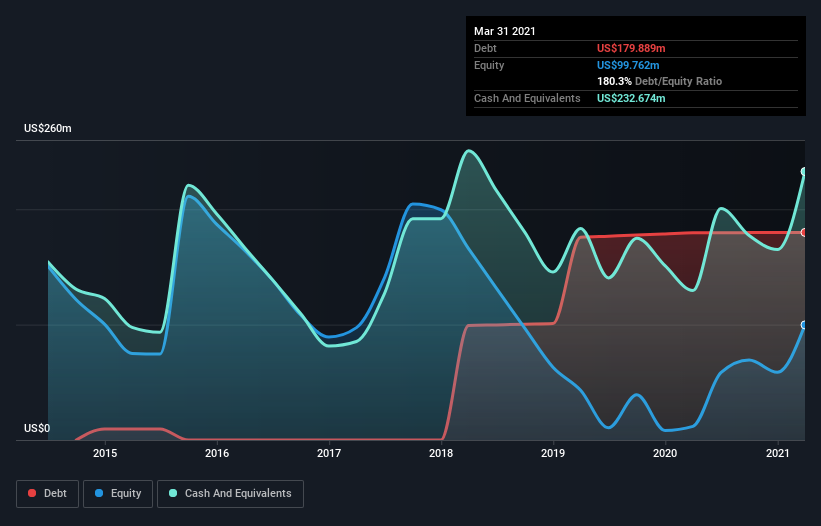Is Dynavax Technologies (NASDAQ:DVAX) Using Debt In A Risky Way?
Howard Marks put it nicely when he said that, rather than worrying about share price volatility, 'The possibility of permanent loss is the risk I worry about... and every practical investor I know worries about.' So it might be obvious that you need to consider debt, when you think about how risky any given stock is, because too much debt can sink a company. We can see that Dynavax Technologies Corporation (NASDAQ:DVAX) does use debt in its business. But the real question is whether this debt is making the company risky.
What Risk Does Debt Bring?
Debt assists a business until the business has trouble paying it off, either with new capital or with free cash flow. If things get really bad, the lenders can take control of the business. However, a more usual (but still expensive) situation is where a company must dilute shareholders at a cheap share price simply to get debt under control. By replacing dilution, though, debt can be an extremely good tool for businesses that need capital to invest in growth at high rates of return. The first thing to do when considering how much debt a business uses is to look at its cash and debt together.
See our latest analysis for Dynavax Technologies
What Is Dynavax Technologies's Net Debt?
The chart below, which you can click on for greater detail, shows that Dynavax Technologies had US$179.9m in debt in March 2021; about the same as the year before. But it also has US$232.7m in cash to offset that, meaning it has US$52.8m net cash.
How Strong Is Dynavax Technologies' Balance Sheet?
We can see from the most recent balance sheet that Dynavax Technologies had liabilities of US$109.4m falling due within a year, and liabilities of US$280.9m due beyond that. Offsetting these obligations, it had cash of US$232.7m as well as receivables valued at US$84.0m due within 12 months. So its liabilities outweigh the sum of its cash and (near-term) receivables by US$73.7m.
Given Dynavax Technologies has a market capitalization of US$1.05b, it's hard to believe these liabilities pose much threat. However, we do think it is worth keeping an eye on its balance sheet strength, as it may change over time. Despite its noteworthy liabilities, Dynavax Technologies boasts net cash, so it's fair to say it does not have a heavy debt load! When analysing debt levels, the balance sheet is the obvious place to start. But ultimately the future profitability of the business will decide if Dynavax Technologies can strengthen its balance sheet over time. So if you're focused on the future you can check out this free report showing analyst profit forecasts.
Over 12 months, Dynavax Technologies reported revenue of US$119m, which is a gain of 195%, although it did not report any earnings before interest and tax. So its pretty obvious shareholders are hoping for more growth!
So How Risky Is Dynavax Technologies?
We have no doubt that loss making companies are, in general, riskier than profitable ones. And the fact is that over the last twelve months Dynavax Technologies lost money at the earnings before interest and tax (EBIT) line. And over the same period it saw negative free cash outflow of US$31m and booked a US$62m accounting loss. With only US$52.8m on the balance sheet, it would appear that its going to need to raise capital again soon. Importantly, Dynavax Technologies's revenue growth is hot to trot. High growth pre-profit companies may well be risky, but they can also offer great rewards. When analysing debt levels, the balance sheet is the obvious place to start. However, not all investment risk resides within the balance sheet - far from it. We've identified 1 warning sign with Dynavax Technologies , and understanding them should be part of your investment process.
If you're interested in investing in businesses that can grow profits without the burden of debt, then check out this free list of growing businesses that have net cash on the balance sheet.
This article by Simply Wall St is general in nature. It does not constitute a recommendation to buy or sell any stock, and does not take account of your objectives, or your financial situation. We aim to bring you long-term focused analysis driven by fundamental data. Note that our analysis may not factor in the latest price-sensitive company announcements or qualitative material. Simply Wall St has no position in any stocks mentioned.
Have feedback on this article? Concerned about the content? Get in touch with us directly. Alternatively, email editorial-team (at) simplywallst.com.

 Yahoo Finance
Yahoo Finance 
